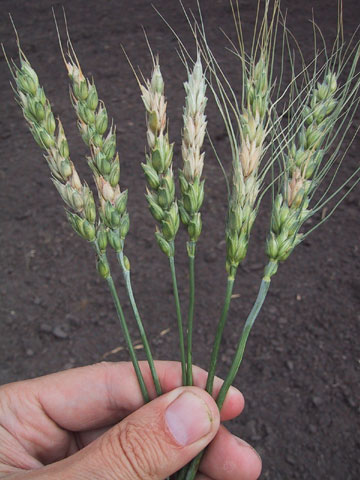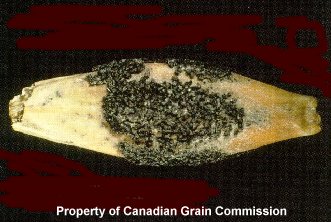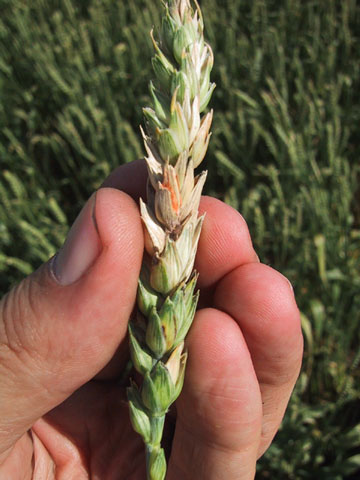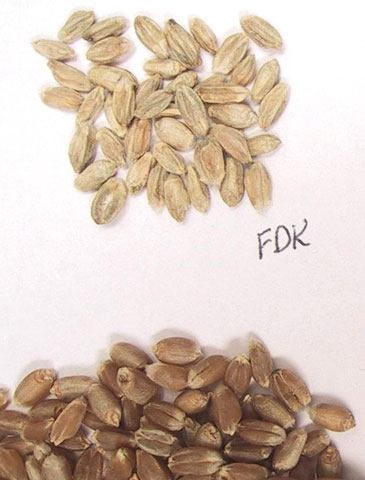Dealing With Fusarium Head Blight
- Crop Rotation and Selection
- Disease Cycle
- Disease Symptoms
- Feeding Guidelines
- Field Management to Prevent Recurrence
- Harvest Techniques to Reduce Fusarium Infected Kernels
- Human Safety Precautions
- Influence of Weather
- Storing Damaged Grain, Greenfeed and Silage
- Stubble Management
- Testing for DON
- Using Infected Grain for Seed
Fusarium head blight is a fungal disease of various grasses that stops kernel development. The disease is most often found in wheat, but can also affect barley, oats, rye and some forage grasses. The first severe outbreak in Manitoba occurred in 1993, but localized outbreaks have been reported since 1986.
Fusarium head blight reduces yields, but a greater concern is the downgrading in quality due to the presence of fusarium damaged kernels. In the top grades, there are very small allowances for infected kernels.


Under certain environmental conditions, the fusarium mould may produce a mycotoxin called DON (deoxynivalenol). DON is relatively mild compared to other toxins sometimes found in grains and forages, but certain precautions should be observed to ensure safe use and handling. The toxin may appear in infected kernels and, to a lesser extent, in the stalks and chaff.
For information on tolerance levels for fusarium-damaged kernels (FDK) please consult the Canadian Grain Commission website - Wheat Grading Factors.
Disease Cycle
Fusarium head blight fungi overwinter as mycelium or spores in crop debris. Seedlings are often infected at emergence. As moist, warm weather develops, spores are dispersed by wind and rain-splash to the aerial parts of the plants. Blight symptoms are most often observed after flowering, usually following a period of continuous moisture with temperatures ranging from 25 to 30 degrees C.
Disease Symptoms
In barley, fusarium head blight first appears as premature bleaching of individual or several spikelets. Investigation of these spikelets will reveal small shriveled seed that become chalk white. Damaged wheat kernels may also be covered in a white to light pink mould. Fusarium damaged kernels may appear healthy in other cereals such as barley and oats, making identification much more difficult.


Influence Of Weather
Fusarium head blight is especially prevalent in humid regions, with outbreaks of the disease in wheat most frequently reported from Quebec, Ontario and the Maritime provinces. In 1993 and 1994, abnormally high mid-summer rainfall occurred in southern Manitoba along with the worst outbreaks of fusarium head blight on record for the area in both wheat and barley.
High levels of moisture favour the disease, with more spores being released on days when rainfall has occurred and on the following one to two days. At 25 degrees C, the disease progresses rapidly when high moisture levels exist for more than 36 hours. At cooler temperatures, the frequency of spore production is reduced.
Harvest and Storage Management
Refer to Managing Fusarium Head Blight at Harvest.
Human Safety Precautions
Fusarium damaged crops can be harvested and handled safely, provided normal precautions are taken to avoid exposure to grain dust. Grain dust is a hazardous substance, regardless of whether or not fusarium is present. Various fungi and moulds in the dust can cause allergic reactions and lung irritation, and prolonged exposure can contribute to serious respiratory problems.
When swathing and combining:A sealed cab should provide adequate protection from grain dust if the air cleaning system and filters have been properly serviced. When working without a cab, try to swath and combine upwind of the dust whenever possible. In dusty conditions, coveralls and a cap will reduce exposure. Goggles can help prevent eye irritation, and a NIOSH-approved, disposable dust mask will reduce dust inhalation.
When working in bins: Coveralls and a dust mask should be worn when handling grain in enclosed areas. A NIOSH-approved disposable dust mask will provide minimal protection, but for greater protection, farmers should consider a half-face mask with a HEPA filter or even a powered purifying respirator (PAPR). Goggles should also be considered to avoid eye irritation.
Other precautions:When taking meal or rest breaks, remove dust-covered overalls and eat in an area free from dust. Always wash your hands before eating. At the end of the day, shower to remove mouldy dust.
Feeding Guidelines
Because DON is a relatively mild toxin, it is unlikely to make animals seriously ill. However, high concentrations of DON in rations can lead to productivity problems such as poor weight gain and greater susceptibility to disease.
The three keys to safe feeding of fusarium damaged grain are:
- testing to determine the DON content,
- careful rationing to keep DON levels within acceptable levels, and
- monitoring to quickly spot any feed refusal problems.
Testing For DON
The only accurate way to measure DON content is to submit a sample for mycotoxin testing to the Canadian Grain Commission or other reputable laboratory. Follow the sampling procedures outlined by these organizations to collect a representative sample.
There is no easy way to reduce the toxicity of DON contaminated grain, other than removing the fusarium damaged kernels or mixing it with uncontaminated grain. Chemical treatments such as aluminum silicate are effective in removing other mycotoxins from feed, but have little impact on the amount of DON.
Field Management To Prevent Recurrence
Weather patterns are by far the greatest factor in the recurrence of fusarium head blight. The disease is most likely to develop when the plants are flowering, temperatures range from 25-30 degrees C and moisture is continuous for 48 to 60 hours within three days after infection. Under these optimum conditions, crop management has little impact on fusarium outbreaks.
Under average conditions, fusarium can be effectively controlled through normal disease management practices. Like other plant diseases where the disease survives on cereal stubble, crop rotation is the most effective control tool.
Crop Rotation And Selection
A break of at least one year -- preferably two years -- is advised between cereal, grass and corn production.
Regardless of the rotation, producers should consider planting cereals that are less susceptible to fusarium head blight. Results from previous years show that durum wheat is more susceptible than hard red spring wheat varieties. Barley is more resistant than wheat, and oats are considerably more resistant than either wheat or barley.
Avoid planting the more susceptible types of wheat in high risk areas such as the southern part of the Red River Valley. Planting two or more varieties of wheat will spread out flowering times and reduce the risk of infection. Planting dates should be staggered within the recommended planting period to vary the flowering dates and reduce disease severity.
For up to date information of current wheat varieties and their levels of resistance to fusarium head blight refer to the most recent edition of your provincial seed guide (Seed Manitoba).
![]()
Stubble Management
Although the fusarium fungus overwinters on crop residues, it isn't necessary to completely eliminate surface debris through extensive tillage or burning. These practices may have little effect on disease prevention and can leave soils vulnerable to erosion.
Even if disease inoculum could be completely eliminated from a field, the crop could be infected by spores blown in from neighbouring fields or from grass along field boundaries. If conditions are favourable for disease development, inoculum from these two sources would allow the disease to develop.
Producers should carry out tillage practices that would normally be used to manage stubble-borne diseases such as tan spot. Crop residue burning is ineffective because it does not destroy the root and crown tissues, which are major overwintering sites of the fungus. Any decision to burn should be based solely on residue management needs, and should be carried out in accordance with Manitoba's Controlled Burning Regulation.
Using Infected Grain For Seed
Wheat crops to be used for seed that are infected with fusarium head blight can be managed to ensure good seed supply. Heavy cleaning of the crop will result in the greatest improvement in quality. Storing fusarium damaged seed under cold temperatures has been shown to reduce germination as compared to seed stored under warm conditions. Seed treatments can also improve germination of infected seed.

